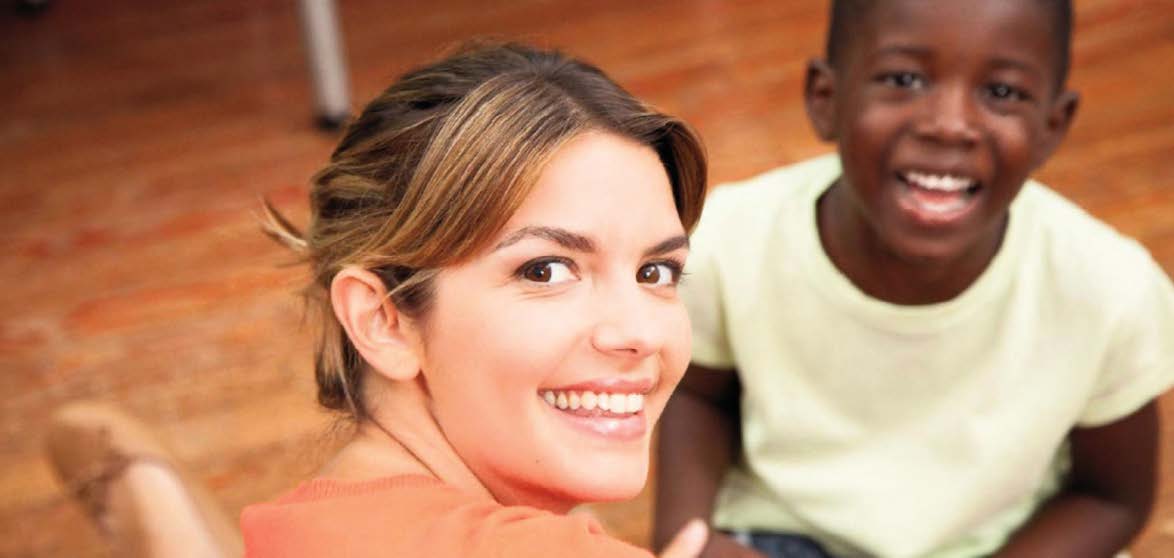
Early comprehensive behavioral intervention led by an experienced board-certified behavior analyst can transform the lives of families and children effected by autism.
BY AMY COOPER MCCOMAS, EDD, BCBA
The Centers for Disease Control and Prevention (CDC) reports that autism spectrum disorder (ASD) affects 1 in 59 children. ASD is a neurobehavioral disorder caused by problems of the central nervous system that affect the communicative, social, and behavioral development of a child; symptoms are typically present within the first three years of life. There are many resources available to help parents monitor child development and understand symptoms. A If concerned about a child's development, it is recommended that parents seek an evaluation from a qualified medical professional.
An autism diagnosis can be challenging for the entire family, but it is important to know that there is hope. A child with autism can grow into a productive, independent adult. Applied behavior analysis (ABA) is an evidence-based best practice for the safe and effective treatment of autism. It is the only autism treatment recommended by the U.S. Surgeon General and most states require that insurance companies cover the treatment. Often referred to as ABA or ABA therapy, treatment is based on the science of learning and behaviors with a focus on actions and consequences. While outcomes vary for each child, every child can make progress with ABA. Collaboration between parents and ABA providers is an important component of each child's success, and early diagnosis allows for early intervention that renews hope and leads to unimaginable progress.
The Joys and Worries of Parenting
The Joys and Worries of Parenting Parenting is one of the most wonderful and challenging human experiences. From the time that precious baby is seen on an ultrasound, parents begin wondering what he or she will be like. They wonder if the baby is growing and developing as they should. Parents want to do everything to give their child the opportunity to have the best life possible.
Overwhelming excitement and concerns increase once baby arrives. The child's first smile melts hearts, waving bye-bye brings happiness all around, and seeing a child share a toy fills parents with pride. Yet, amidst this joy, parents are often questioning if their child should be doing more or doing something differently. Parents know their child best, but it can be difficult to know if a child is developing on pace. Every child develops at his or her own rate, but parents should be monitoring development. Especially in the early stages of newborn to four years old, parents may find themselves asking questions such as:
• Should they have rolled over by now? • When are they going to say dada or mama? • How many words should they know now? • Does every child tantrum like this? • Should they be able to stack rings yet? • Should they be playing more with other kids? • How do I know if these things are happening on schedule?
Each day more questions arise. Fortunately, there are many resources available to help parents better understand when children should be reaching certain developmental milestones. The CDC provides a concise overview of what skills and behaviors should be present at each stage of development and a questionnaire that can help parents decide if they should seek out a medical evaluation. Another great resource is the CDC's Milestone Tracker App, which can help parents track when a child is reaching developmental milestones. Well-child doctor visits are also important for monitoring a child's development.
Understanding the Diagnosis Process
Help from a medical professional is paramount if a parent suspects their child is not reaching developmental milestones. An evaluation by a pediatrician or psychologist will help a parent determine if their child is developing appropriately or if there is a delay. If it is determined a developmental delay exists, they will also determine if further evaluation is needed for a diagnosis. There are many reasons for developmental delays—some are simply delays and others are diagnosable conditions, including autism.
It is important to understand that there is no definitive method for diagnosing autism. ASD is a spectrum disorder, so not all symptoms are present or look the same for each person with autism. Because of this, the diagnostic process is involved and should be conducted by a physician or psychologist with autism experience. To determine if a child has autism, a medical professional will examine three key areas of development: communication, social, and behavioral.
For communication development, they will evaluate if a child is lacking in speech and language or if language seems repetitive. For social development, they will evaluate if a child is making appropriate eye contact, engaging with peers, and able to interact age-appropriately in social situations. For behavioral development, medical professionals rely on parents to report on a child's play, eating, and sleeping habits, and note any repetitive or stereotyped behaviors such as flapping the hands. Medical professionals will directly observe and interact with the child as well to monitor for specific, heightened interests and challenging behaviors during the evaluation.
THE OBSERVANT PARENT : A MILESTONES CHECKLIST
Parents know their children best. If you notice any of these signs of possible developmental delays, make an appointment with a pediatrician or psychologist who has experience with autism. Visit cdc.gov/ActEarly for more comprehensive milestone tracking resources.
At 2 Months • Doesn't respond to loud sounds • Doesn't watch things as they move • Doesn't smile at people • Doesn't bring hands to mouth • Can't hold head up when pushing up when on tummy
At 4 Months • Doesn't watch things as they move • Doesn't smile at people • Can't hold head steady • Doesn't coo or make sounds • Doesn't bring things to mouth • Doesn't push down with legs when feet are placed on a hard surface • Has trouble moving one or both eyes in all directions
At 6 Months • Doesn't try to get things that are in reach • Shows no affection for caregivers • Doesn't respond to sounds around him • Has difficulty getting things to mouth • Doesn't make vowel sounds ("ah", "eh", "oh") • Doesn't roll over in either direction • Doesn't laugh or make squealing sounds • Seems very stiff, with tight muscles • Seems very floppy, like a rag doll
At 9 Months • Doesn't bear weight on legs with support • Doesn't sit with help • Doesn't babble ("mama", "baba", "dada") • Doesn't play any games involving back-and-forth play • Doesn't respond to own name • Doesn't seem to recognize familiar people • Doesn't look where you point • Doesn't transfer toys from one hand to the other
At 1 year • Doesn't crawl • Can't stand when supported • Doesn't search for things that she sees you hide • Doesn't say single words like "mama" or "dada" • Doesn't learn gestures like waving or shaking head • Doesn't point to things • Loses skills he once had
At 18 Months • Doesn't point to show things to others • Can't walk • Doesn't know what familiar things are for • Doesn't copy others • Doesn't gain new words • Doesn't have at least 6 words • Doesn't notice or mind when a caregiver leaves or returns • Loses skills he once had
At 2 years • Doesn't use 2-word phrases (for example, "drink milk") • Doesn't know what to do with common things, like a brush, phone, fork, spoon • Doesn't copy actions and words • Doesn't follow simple instructions • Doesn't walk steadily • Loses skills she once had
At 3 years • Falls down a lot or has trouble with stairs • Drools or has very unclear speech • Can't work simple toys (such as peg boards, simple puzzles, turning handle) • Doesn't speak in sentences • Doesn't understand simple instructions • Doesn't play pretend or make-believe • Doesn't want to play with other children or with toys • Doesn't make eye contact • Loses skills he once had
At 4 years • Can't jump in place • Has trouble scribbling • Shows no interest in interactive games or make-believe • Ignores other children or doesn't respond to people outside the family • Resists dressing, sleeping, and using the toilet • Can't retell a favorite story • Doesn't follow 3-part commands • Doesn't understand "same" and "different" • Doesn't use "me" and "you" correctly • Speaks unclearly • Loses skills he once had
At 5 years • Doesn't show a wide range of emotions • Shows extreme behavior (unusually fearful, aggressive, shy or sad) • Unusually withdrawn and not active • Is easily distracted, has trouble focusing on one activity for more than 5 minutes • Doesn't respond to people, or responds only superficially • Can't tell what's real and what's make-believe • Doesn't play a variety of games and activities • Can't give first and last name • Doesn't use plurals or past tense properly • Doesn't talk about daily activities or experiences • Doesn't draw pictures • Can't brush teeth, wash and dry hands, or get undressed without help • Loses skills he once had
SOURCE: CDC.GOV/NCBDDD/ACTEARLY/PDF/CHECKLISTS/ALL_CHECKLISTS.PDF

HOPE DRIVES THE PROCESS: Applied behavior analysis (ABA) treatment is often delivered one-on-one for up to 40 hours each week and may be recommended for two to four years or more.
Early diagnosis is critical as it provides the opportunity for early intervention. The American Academy of Pediatrics recommends screening for ASD at 18 months, 24 months, or whenever there is concern that a child may be showing developmental delays. Often times, parents do not realize their child is showing signs of autism until they enter school. It may be an educator who first suggests a child should be evaluated by a medical professional. If so, the child's school may also assess the child to determine if additional educational supports are recommended. An evaluation conducted by a school educator is different than the developmental evaluation that is conducted by a medical professional.
After an Autism Diagnosis
Help is available for the entire family. Decades of research prove that ABA is an effective treatment for autism. ABA is a comprehensive, individualized, and data-driven treatment that breaks skills down into many small steps and uses positive reinforcement to build skills and decrease problem behaviors. Care teams comprised of board certified behavior analysts (BCBAs), board certified assistant behavior analysts (BCaBAs), and registered behavior technicians (RBTs) specifically assess each child and develop a plan of action. ABA treatment is often delivered one-on-one with a child for up to 40 hours each week and may be recommended for two to four years or more. Studies demonstrate that early intervention with ABA yields positive outcomes for children. ABA treatment may take place in a clinic, in the home, or a combination of both. Children with autism often have difficulty using new skills in a variety of settings, so it is important to address this accordingly in each child's treatment plan. Additionally, extensive parent training on ABA approaches is an important component of effective treatment. Close collaboration between parents, medical professionals, and educators is beneficial in ensuring a child has the best opportunity for progress.
The achievements of children with autism varies tremendously and no assessment can predict how a child will progress through ABA treatment. However, research indicates that approximately half of children with ASD that receive the recommended course of ABA treatment can transition into school with no additional supports. Approximately 40 percent can successfully transition into school but may need some additional supports. This may include an individualized education plan (IEP) at school or support at other stages in life, such as at major developmental stages like adolescence or entering adulthood. The other 10 percent of children who receive comprehensive ABA treatment will make some gains and continue to need support throughout their lifetime.
It is important to know that every child with autism can make progress with ABA. As dedicated behavior analysts approach each child with the intention of helping them reach their greatest potential, parent training and collaboration are also essential to the treatment process. When a loved one has autism, it impacts the entire family. Those who are struggling and need help navigating an autism diagnosis can seek out a local ABA treatment provider who will partner with them to understand their unique issues and help solve problems.
There is Always Hope
There is Always Hope Hope drives the process of assessment, diagnosis, and treatment of every child with autism. Early comprehensive behavioral intervention led by an experienced board-certified behavior analyst can transform the lives of families and children affected by autism. ABA treatment accelerates learning so children improve their communication skills, social interactions, and engage in more appropriate behaviors. The future is bright and full of opportunities for every child to grow and thrive.•

ABOUT THE AUTHOR: Dr. Amy Cooper McComas, EdD, BCBA, is a nationally recognized behavior analyst with more than 15 years' experience providing ABA treatment. She presents at behavior analysis conferences, has held academic positions at Ball State University and Grace College, and served in multiple clinical leadership roles before founding Great Heights in the Midwest. Dr. Cooper McComas is passionate about the proven benefits of ABA and is dedicated to helping families find hope through achievement and results.